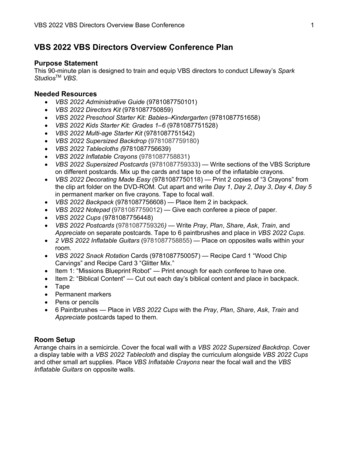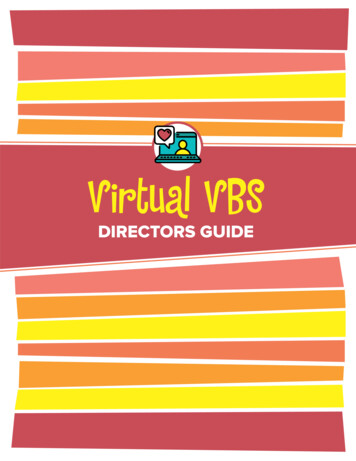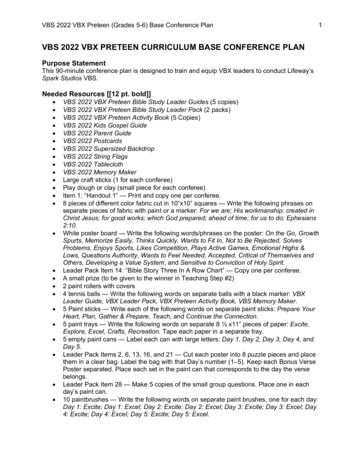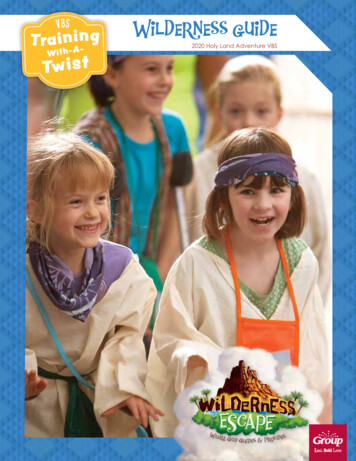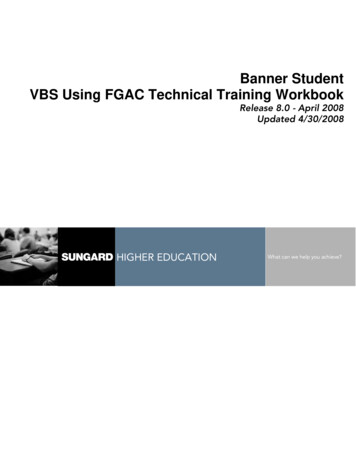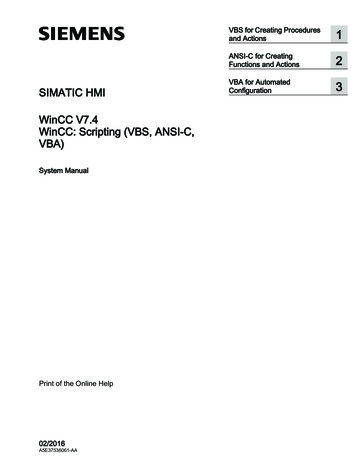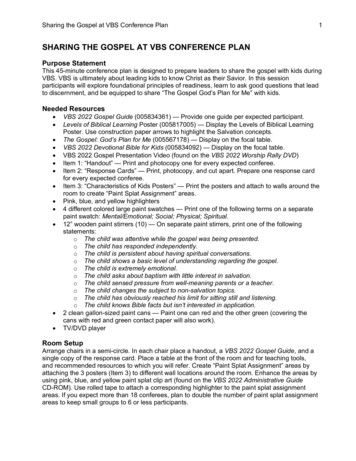
Transcription
Sharing the Gospel at VBS Conference Plan1SHARING THE GOSPEL AT VBS CONFERENCE PLANPurpose StatementThis 45-minute conference plan is designed to prepare leaders to share the gospel with kids duringVBS. VBS is ultimately about leading kids to know Christ as their Savior. In this sessionparticipants will explore foundational principles of readiness, learn to ask good questions that leadto discernment, and be equipped to share “The Gospel God’s Plan for Me” with kids.Needed Resources VBS 2022 Gospel Guide (005834361) — Provide one guide per expected participant.Levels of Biblical Learning Poster (005817005) — Display the Levels of Biblical LearningPoster. Use construction paper arrows to highlight the Salvation concepts.The Gospel: God’s Plan for Me (005567178) — Display on the focal table.VBS 2022 Devotional Bible for Kids (005834092) — Display on the focal table.VBS 2022 Gospel Presentation Video (found on the VBS 2022 Worship Rally DVD)Item 1: “Handout” — Print and photocopy one for every expected conferee.Item 2: “Response Cards” — Print, photocopy, and cut apart. Prepare one response cardfor every expected conferee.Item 3: “Characteristics of Kids Posters” — Print the posters and attach to walls around theroom to create “Paint Splat Assignment” areas.Pink, blue, and yellow highlighters4 different colored large paint swatches — Print one of the following terms on a separatepaint swatch: Mental/Emotional; Social; Physical; Spiritual.12” wooden paint stirrers (10) — On separate paint stirrers, print one of the followingstatements:o The child was attentive while the gospel was being presented.o The child has responded independently.o The child is persistent about having spiritual conversations.o The child shows a basic level of understanding regarding the gospel.o The child is extremely emotional.o The child asks about baptism with little interest in salvation.o The child sensed pressure from well-meaning parents or a teacher.o The child changes the subject to non-salvation topics.o The child has obviously reached his limit for sitting still and listening.o The child knows Bible facts but isn’t interested in application.2 clean gallon-sized paint cans — Paint one can red and the other green (covering thecans with red and green contact paper will also work).TV/DVD playerRoom SetupArrange chairs in a semi-circle. In each chair place a handout, a VBS 2022 Gospel Guide, and asingle copy of the response card. Place a table at the front of the room and for teaching tools,and recommended resources to which you will refer. Create “Paint Splat Assignment” areas byattaching the 3 posters (Item 3) to different wall locations around the room. Enhance the areas byusing pink, blue, and yellow paint splat clip art (found on the VBS 2022 Administrative GuideCD-ROM). Use rolled tape to attach a corresponding highlighter to the paint splat assignmentareas. If you expect more than 18 conferees, plan to double the number of paint splat assignmentareas to keep small groups to 6 or less participants.
Sharing the Gospel at VBS Conference Plan2Teaching Steps1. Introduction (2 minutes) Say: “For many churches, VBS is the #1 evangelistic event of the year. Statistically,more people come to know Christ as a result of VBS than any other organizedprogram in our churches. That said, understanding how to lead a child from hearingthe gospel to responding to the gospel is one of the most important tools/skills onour VBS toolbelt.” Continue: “In this session we will consider the foundations of salvation, learn torecognize a child’s readiness to respond to the gospel, and then walk throughleading a child through a gospel presentation.” Pray. Ask God to lead during this important time together.2. Understanding the General Characteristics of Kids (15 minutes) Say: “Understanding general characteristics of kids will lay a wise foundation forsharing the gospel with boys and girls.” Explain that Luke 2:52 teaches us that Jesus increased in “wisdom, and in stature,and in favor with God, and with man.” We know that while fully God, Jesus was alsofully man, and he grew according to God’s plan for how children grow. Jesus grewmentally and emotionally (in wisdom), physically (in stature), spiritually (in favor withGod), and socially (in favor with man). We can expect boys and girls to grow inthese ways, too. Group participants into 3 color splat teams by numbering them off by colors: pink,blue, yellow. Lead conferees to move to their color splat assignment sheets. Quicklylead a group member to pull a prepared paint swatch from the can to determinetheir team’s category assignment (Mental/Emotional, Physical, Spiritual, Social). Say: “Each color team is now standing at an age level chart: 1st & 2nd (pink), 3rd & 4th(blue), or Preteen (yellow). You also have a category printed on your team’s chosenpaint swatch. Over the next three minutes your group is to read aloud thecharacteristics under your assigned category and highlight the characteristics thatare especially relevant when talking with kids about salvation. Be prepared to sharethe statements your team has highlighted and why those characteristics areimportant.” Allow 2-3 minutes for groups to work. Then lead each group to elect a spokesmanto report their group’s thoughts. (Other team members may return to their seats.) Refer to the Levels of Biblical Learning poster and encourage conferees to consultwith that resource for additional understanding of the concept of salvation.3. Asking Good Questions (5 minutes) Mention that at VBS we often don’t have the luxury of really knowing all the kids.We’re asked to make quick assessment of a child’s readiness to respond to thegospel often based on limited knowledge of the child’s understanding. We mustheavily depend on the Holy Spirit to help us discern a child’s readiness. Explain that asking “good” questions can help. There are three types of questions: Closed Questions: Questions that can simply be answered with a simple“Yes” or “No.” Limited Questions: Questions that can be answered with a correct answer. Open-Ended Questions: Questions that spark conversation that helpreveal a child thoughts and feelings.
Sharing the Gospel at VBS Conference Plan 3Ask participants for examples of closed questions that might be asked when talkingwith a child about salvation (accept 2-3 quick replies). Continue by asking for limitedquestions (2-3 quick replies), then open-ended questions. Emphasize theimportance of asking as many open-ended questions as possible.4. “Stop and Pray” or “Prayerfully Proceed” (10 minutes) Say: “So, we’ve done our homework we have some general understanding of thekids we’re leading, we’ve prepared some good questions, now what? How can weknow if a child really is ready to make Jesus her Savior and Lord? You can’t!Unfortunately, there’s not a “black and white” answer. There is no ‘litmus test’ todetermine a child’s readiness. However, you can trust the Holy Spirit, seek Hisguidance, believe in His love, grace, and mercy, and prayerfully proceed.” Call attention to the 10 prepared paint stirrers. Invite conferees to pull a paint stirrer,read the printed statement, and encourage the group to determine if that stirrergoes in the “Stop and Pray” can (red) or the “Prayerfully Proceed” can (green).5. Sharing the Gospel (12 minutes) The Gospel: God’s Plan for Meo Lead the group to view the VBS 2022 gospel presentation video and tofollow along by using the VBS 2022 Gospel Guide (previously placed in theirseats). Explain that this tool can be a helpful reminder (memory prompter)as they lead a child through a gospel presentation. Helping a Child Respond to the Gospelo Call attention to the “We Respond” portion of the outline. Emphasize that thetransition from “sharing the gospel” to “responding to the gospel” is veryimportant. Again, encourage participants to lean heavily on the guidance ofthe Holy Spirit. Be careful to recognize if the child is still attentive andresponsive. If he’s “moved on” or has reached his limit for sitting still andlistening, schedule another time to continue the conversation.o If you feel led to continue, the following transition statements can be helpful:§ Have you ever made the decision to respond to the gospel?§ Do you think you’re ready to Admit, Repent, Believe, and Confess? Review the Response Cardso Refer to the response card (previously placed in their seats). Explain thatLifeway’s VBS curriculum encourages leader to use a response card toallow kids to make a private decision. This response card will require followup on the part of leaders but can help ensure that a child’s decision is basedon his personal convictions. Understanding What the Bible Says about Being Savedo The Bible says: if we believe and confess, we will be saved.§ John 3:16: For God loved the world in this way: He gave his one andonly Son, so that everyone who believes in him will not perish buthave eternal life.§ 1 John 1:9: If we confess our sins, he is faithful and righteous toforgive us our sins and to cleanse us from all unrighteousness.§ Romans 10:9-10: If you confess with your mouth, “Jesus isLord,” and believe in your heart that God raised him from thedead, you will be saved. One believes with the heart, resulting inrighteousness, and one confesses with the mouth, resulting insalvation.
Sharing the Gospel at VBS Conference Plan Confess and believe. That’s the simple response to God’s plan for you.6. Close with Prayer (1 minute) Close in prayer. Ask God to go before us, prepare the way for us, and give usopportunities to share His story with His kids this year during VBS.4
Sharing the Gospel at VBSUnderstanding Characteristics of Kids:Asking Good Questions:STOP & PRAY:Closed Questions:Limited Questions:PRAYERFULLY PROCEED:Open-Ended Questions:Responding to the Gospel:Item 1. Handout
Item 2
Characteristics of Younger KidsMental: Have a limited ability to think abstractlyCan follow specific short and simple instructionsFrequently ask teachers for helpWant their work to be perfect and are afraid to failLove to ask questionsAre eager to learnPhysical: Are developing small muscle control and hand-eye coordination Are extremely active and have difficulty sitting still for long periods oftime Use their entire body to learn Can be sloppy and in a hurry; speed is a benchmarkSpiritual: See Jesus as a friend and helperAre beginning to feel the need to trust Jesus as SaviorAre beginning to have a simple understanding of sin and the GospelMay know the right answers but not understand the applicationAre beginning to understand truth and honesty, right from wrongAre beginning to recognize the consequences for their sinSocial/Emotional: Are moving toward independence but still needs frequent assuranceTend to focus on their own needs before othersAre sensitive to what others think and desire approvalCry easily when scoldedMay avoid new situationsAre often talkativeCan be self-centeredItem 3. Characteristics of Kids Posters
Characteristics of Middle KidsMental: Attention spans are lengtheningCan be involved in experiences that deal with feeling and thinkingAccept carefully worded criticismAre beginning to think abstractlyAre eager to learnPhysical: Are active, energetic, and enthusiastic by nature and need and outlet forthose physical characteristics with active learning experiences May overdo it with physical activities and have trouble calming down Have slow, steady growth and good muscle control; girls usuallydevelop more quickly than boysSpiritual: Are developing values and thinking in terms of right or wrong instead ofgood and bad Are learning that the Bible tells of God’s plan of salvation Can memorize short Bible passages and learn and apply Bible truthsabout salvation Can ask serious questions about religion Can follow the examples, teachings, and commandments of Jesus Are aware that God loves and values all peopleSocial/Emotional: Like to work in groups and focus on fairness Are in the process of building relationships, usually loyal to their friends(generally of the same gender) and want to be helpful to the group orteam Are increasing in their self-concept Can be strong-willed at times as they seek ways to show independence. Are generally sensitive, their feelings are hurt easily, and they can cryeasilyItem 3. Characteristics of Kids Posters
Characteristics of PreteensMental: Are capable of thinking abstractlyCan distinguish between fact and fictionAre capable of deep thoughtsHave developed basic reading and writing skillsCan concentrate when interestedPhysical: Are experiencing growth spurtsCan be noisy and boisterousEnjoy competition, active games, and like to winLike to use abundant energy and physical skillsAre approaching puberty; girls are usually ahead of boysSpiritual: Can be sensitive to the conviction of the Holy SpiritHave developed concepts of love and trustAre developing their own conscience and value systemBeginning to adopt a belief system of their ownAre ready for spiritual answers and directionAre learning the limits of behaviorSocial/Emotional: Like acceptance and need approval of their peersCan be easily discouragedEnjoy companionshipCan be sensitive to othersAre worried about fitting in and rejectionExperience extreme emotionsAre easily influenced emotionallyAre beginning to be interested in the opposite sexItem 3. Characteristics of Kids Posters
Sharing the Gospel at VBS Conference Plan 2 Teaching Steps 1. Introduction (2 minutes) Say: "For many churches, VBS is the #1 evangelistic event of the year. Statistically, more people come to know Christ as a result of VBS than any other organized program in our churches. That said, understanding how to lead a child from hearing
